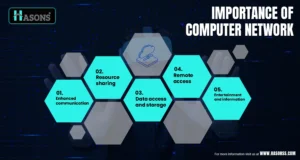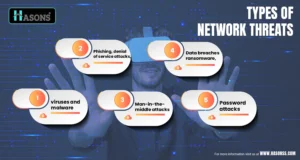Uses of Computer Networks for People
A computer network connects devices to actively share resources and exchange information. Uses of computer networks include communication, data sharing, and resource management. These networks can exist with a small connection of two PCs in a single home and span as far as letting millions of PCs in different countries connect. Signals transmitted through wireless, wired, or a combination of both mediums create the linkages in a network, enabling devices to interact effectively.
In the most basic sense, it is the interconnection of computers to share peripheral devices, disks and files and to connect to the internet. Devices can interconnect using certain protocols when connected to a network, ensuring that data is passed from one device to another with minimal errors.
Various industries benefit from computer networks including education, business, entertainment, and health industries. These are essential for the provision and support of a myriad of applications such as online classes and telecommuting, video and music streaming and telemedicine among others. The development of technology today highlights the undeniable importance of uses of computer networks in enabling modern connections and productivity.
Importance of Computer Network

Enhanced Communication: Networks facilitate communication in real-time through the use of many tools that are there in the modern market such as e-mail, messaging, and video and voice communication tools. This capability erases physical space and it cultivates human relationships in the personal sphere as well as the business world.
Resource Sharing: One of the benefits of computer networks is resource sharing where many computers can share the same resources such as printers, files and internet connections. This reduces the cost of procuring hardware and ensures that the equipment is used more efficiently, rather than having multiple similar or different devices.
Data Access and Storage: Networks allow data to be stored in a single location and accessed from any node, facilitating collective data management. This setup is especially important in organizations where more than one person needs to input data, retrieve it and modify it at the same time.
Remote Access: Having an option of working and accessing materials in the network from a remote place is an important factor for today’s workplace. It supports work-from-home and online classes; thus, people can access their organizational systems regardless of location.
Entertainment and Information: Networks also cater to some entertainment services such as streaming services, online gaming and social networking services. They also provide a wide range of information and learning materials to the general public, helping people stay informed and entertained.
Components of Computer Network
Network Devices:
- Routers: Routers switch data packets between two or more networks and regulate traffic to increase the efficacy of the data transfer. These are important in teleporting local area networks to the internet and canaring that data to the intended destination.
- Switches: Switches as a part of a network join devices together, and forward information only to the target device. They help to reduce network clutter hence improving the efficiency of the network.
- Hubs: Switches are fundamental networking devices that transmit data to every connected device. They are less efficient than switches because they cannot distinguish the endpoints for delivering data packets, which can significantly cause traffic jams in the network.
- Access Points: There are connection points that facilitate connection of a Wireless network which connects any device to a network by use of Wi-Fi. Developers require them to create and expand wireless networks.
Links:
- Wired Links: It is a connection that is based on the use of cables such as Ethernet cables or fiber cables to provide a secure and high-speed link. People typically choose them for their stability and the speed at which they execute instructions.
- Wireless Links: Wired connections employ cables for their data transfer whilst wireless connections employ radio waves for connection; some of the wireless connections include Wireless fidelity commonly referred to as Wi-Fi as well as Bluetooth.
Communication Protocols:
- TCP/IP: The Internet primarily relies on TCP/IP as its principal protocol for communication. It is responsible for the communication and the delivery of data packets all over the network.
- HTTP/HTTPS: The World Wide Web relies on two protocols for accessing, transferring and viewing hosted documents and info namely Hypertext Transfer Protocol (HTTP) and the secure version of HTTP (HTTPS). HTTPS has utilizable encrypting capabilities used for safe conveyance.
- FTP: FTP is an application that allows the inter-transfer of files from one device to another in a network. People extensively adopt it for transferring documents between clients and servers.
Network Defense:
- Firewalls: A firewall is essentially the mechanism that scrutinizes the incoming as well the outgoing traffic following certain security parameters decided by the specific company.
- Intrusion Detection Systems (IDS): IDSs patrol the network, surveilling for any malicious activities, and trigger an alarm if they detect any.
- Virtual Private Networks (VPNs): VPNs protect information transmitted over the Internet by encrypting the data, ensuring secure communication.
Types of Network Threats

- Viruses and Malware: Malware, such as viruses, worms, and ransomware, pose harm in terms of corrupting files, embezzling information, or halting network performances. These threats warrant routine updates and security measures, as attackers can exploit vulnerabilities.
- Phishing: Phishing scams aim at tricking the users into divulging sensitive information under the guise of a genuine institution such as a bank or service provider. Attackers typically carry out such attacks through phishing, sending fake emails or messages to unsuspecting users.
- Denial of Service (DoS) Attacks: DoS attacks flood a network with traffic that it cannot handle and therefore make the network unavailable to anyone who wants to use it. Distributed Denial of Service (DDOS) attacks are carried out by one target being attacked by multiple systems.
- Man-in-the-Middle (MitM) Attacks: Man-in-the-middle (MitM) attacks intend to compromise and may even modify data interchange between two parties without their consent. This type of attack can endanger data and interface with other gadgets in the system.
- Data Breaches: It means that the unauthorized person may intercept as well as steal or misuse some sensitive data. Hacking, internal threats and poor security measures are ways through which data may be breached.
- Ransomware: Ransomware locks a victim’s data and then demands a ransom for its decryption. Abnormalities can bring about major disturbances to commercial activities and data information access.
- Password Attacks: Password attacks include: guessing, cracking and stealing of passwords. You can address this danger by using strong, specific passwords and multi-factor authentication procedures.
Computer Networks: Business Application
- Data Management: Networks facilitate data storing and retrieval systems as well as data security because they help facilitate the organization’s data storage system. This has the added advantage of ease of backup and recovery as well as sharing of information across the system.
- Collaboration Tools: Most common applications include shared documents, project management systems as well as communication systems all of which increase instance connectivity between teams. All these tools enhance real-time cooperation and sharing of information.
- Customer Relationship Management (CRM): Applications enjoy network connectivity in that CRM systems track customer interactions, and sales and enhance customer services. Third, networks allow CRM systems to connect with other business applications and give more meaningful information.
- Supply Chain Management: Some of its roles include the provision of interaction with suppliers, distributors, and logistics providers. An accurate supply chain uses the effective flow of data sharing and integration with different systems.
- Remote Work: Networks facilitate remote working by making it possible for employees timely and securely access organizational resources, applications, and communication platforms from anywhere. This flexibility also aims to improve efficiency, it also caters for the various working situations.
Objectives of creating and Deploying a computer network
- Cost Reduction: Through the sharing of resources and reduction in the usage of hardware the networks end up saving costs. For instance, while one single printer or server can be used for several people’s benefit, there is no need to purchase more hardware.
- Enhanced Efficiency: These networks enhance the flow of communications and the distribution of resources within systems thus enhancing the flow of work. This usually enhances the effectiveness of the operation since it involves a variety of operations that can be done in one central place.
- Scalability: Effective and efficient networks are expandable in a way that they can fit an organization’s growth plan and expand with it. This flexibility substantiates future growth in terms of lending new users, devices and other more and more applications that can be merged without conditioning various infrastructure changes.
- Improved Communication: Endorsement of the networks supports internal and external communication making the sharing of information fast and efficient. Proper tools of communication enhance the quality of decisions made and the cooperation that takes place.
- Data Security: You should implement security measures within a network to protect data from unauthorized access, breaches, and cyber threats. Security measures and safeguards are indispensable for the protection of the information.
- Centralised Management: Networks enable the coordination of resources and systems within the center hence enabling easy assessment and control of the infrastructure. Management of the network is eased since it is controlled from a central point hence easy to diagnose.
Future Trends in Networking
- 5G Technology: The actual availability of the 5G networks enables higher data rates, reduced delay, and higher numbers of connected devices. They believe that this technology will bring tremendous changes to mobile communication, IoT applications, and smart cities.
- Edge Computing: Edge computing processes some data away from large data centers to reduce latency and enhance the performance of applications like self-driving cars and big data analysis.
- Software-defined networking (SDN): SDN is a more flexible and efficient way of network management as compared to conventional architecture because of its decoupling into control and data planes. It was made to support flexible configuration of resources within a network and enhance its scalability.
- Network Virtualization: Network virtualization means the creation of many virtual networks on top of the shared physical infrastructure. This approach improves the possibilities for scalability, usage of resources, and management of the network topology.
- IoT Expansion: The expansion of IoT development connects new and increasingly diverse objects to networks. The software upgrade and the advancement in the Internet of Things will also lead to an increased need for an efficient network in the administration and management of large volumes of data and devices.
Conclusion
Computer networks are a crucial aspect of modern society, playing a central role in the sharing of resources as well as information exchange. Knowledge about components of computer networking, threats on usage, the applications of Computer networks and future integration improves the use of this resource by individuals and organizations. As that technology evolves the only way for the company is to learn about the new opportunities and risks that networks present.
| You’re reading a Uses of Computer Network article. Explore more articles. | |
| Best budget Desktop for students 2024 | Neural network architecture |
| COPA Full Form | 100 Shortcut Keys in Computer |
Uses of computer network
- What are the main uses of computer networks?Computer networks are used for enhancing communication, sharing resources, accessing and storing data, enabling remote work, and providing entertainment and information services.
- What are the benefits of using computer networks?Benefits include improved communication, cost reduction through resource sharing, enhanced productivity, remote access capabilities, and access to a wide range of information and services.
- What are the potential challenges of computer networks?Challenges include security threats, such as viruses and malware, potential for data breaches, network congestion, and the complexity of managing and maintaining network infrastructure.
- What are the common types of computer networks?Common types include Local Area Networks (LANs), Wide Area Networks (WANs), Personal Area Networks (PANs), Metropolitan Area Networks (MANs), and Wireless Local Area Networks (WLANs).
